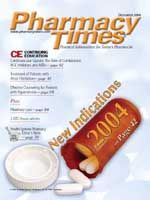Drug Interactions and QT Interval Prolongation
A recent report noted an increased risk of sudden death from cardiac causes in patients taking erythromycin and a concurrent inhibitor of CYP3A4.1 Of 10 patients taking erythromycin who had a sudden cardiac death, 3 also were taking CYP3A4 inhibitors. The risk of death in these patients was estimated to be 5 times greater (15.5/1000 person-years vs 3.2/1000 person-years), compared with patients using CYP3A4 inhibitors (diltiazem and verapamil) who were not taking erythromycin. The risk of death in erythromycin users not receiving concurrent CYP3A4 inhibitors was not increased, compared with patients not taking the antibiotic.
Erythromycin has been shown to be associated with prolongation of cardiac muscle repolarization. This repolarization may lead to ventricular arrhythmias, notably torsades de pointes. The authors of the article hypothesize that diltiazem and verapamil may be associated with increased erythromycin toxicity because of their ability to inhibit CYP3A4, the enzyme responsible for the metabolism of erythromycin.
This report illustrates many of the difficulties associated with evaluating drug interactions that affect cardiac conduction, particularly myocardial cell repolarization. A large number of drugs and endogenous factors (Table) have been reported to delay repolarization. In the absence of delayed ventricular conduction, delayed ventricular repolarization usually is identified by the presence of a prolonged QT interval on the electrocardiogram (ECG). Prolonged QT intervals can result in premature ventricular complexes that can lead to syncope, dizziness, palpitations, ventricular tachycardia, and sudden death?or they can be asymptomatic.
Erythromycin is known to prolong the QT interval.2 Because erythromycin inhibits its own metabolism, an important question regarding the proposed mechanism is, how much additional inhibition of erythromycin metabolism could diltiazem or verapamil produce? Other potential explanations for the study results include erythromycin-induced arrhythmias or erythromycin inhibition of the metabolism of diltiazem and verapamil leading to cardiac toxicity.
QT Prolongation Associated with Drug Interactions
Drugs associated with QT prolongation include those drugs that predictably prolong the QT interval. They are all used to treat arrhythmias and include quinidine, procainamide, amiodarone, sotalol, and dofetilide (referred to as Class I drugs).
Secondly, there are a number of drugs that have been shown to prolong the QT interval, often at elevated serum concentrations, and may produce arrhythmias (Class II). Examples would include amitriptyline, cisapride, erythromycin, pimozide, and thioridazine.
Finally, there are a large number of drugs with limited or minimal ability to prolong the QT interval (Class III). All of these drugs associated with QT prolongation could interact based on pharmacodynamic (PD) and/or pharmacokinetic (PK) mechanisms.
To put some perspective on the risks associated with drug interactions that may result in QT prolongation, the following general approach is suggested.
Drug Combinations to Avoid
- 2 Class I drugs (PD interaction)? eg, quinidine plus dofetilide
- A Class I drug plus a Class II drug when there is also a PK interaction (PD plus PK)?eg, quinidine plus thioridazine
Drug Combinations to Avoid Unless Benefit Outweighs Risk
- A Class I drug plus a Class II drug when there is no PK interaction (PD only)?eg, procainamide plus cisapride
- 2 Class II drugs when there is also a PK interaction (PD plus PK)?eg, erythromycin plus cisapride
Drug Combinations Where Close Monitoring Is Required
- 2 Class II drugs when there is no PK interaction (PD only)?eg, amitriptyline plus cisapride
Combinations of Class III drugs may result in increased QT prolongation. Patients with any of the risk factors listed in the Table should be monitored carefully, and therapy with alternative agents posing no risk for delayed repolarization should be considered. Patients with preexisting QT prolongation or a prior history of long-QT syndromes are probably at increased risk of developing arrhythmias and require careful ECG monitoring.
Drs. Horn and Hansten are both professors of pharmacy at the University of Washington School of Pharmacy. For an electronic version of this article, including references if any, visit www.hanstenandhorn.com.

